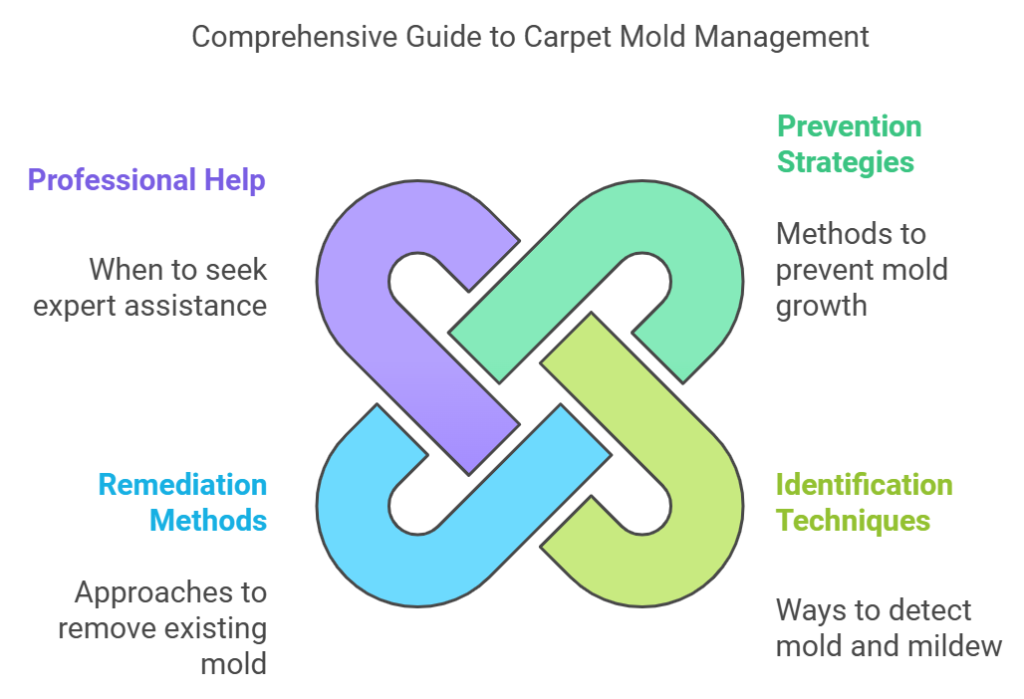To prevent mold and mildew in carpet, control humidity levels by using dehumidifiers and air conditioners to keep indoor humidity between 30-50%. Clean spills immediately and dry the carpet thoroughly. Ensure proper ventilation by using fans and keeping air vents clear. Vacuum regularly and consider professional carpet cleaning annually. Use mold-resistant carpet padding and treatments, and periodically inspect for signs of mold.
Identifying Mold and Mildew
Mold and mildew can appear as discolored patches on the carpet. These patches may be black, green, white, or gray and can vary in size. Look for spots that seem to grow over time. Pay close attention to areas that are consistently damp, such as near windows, under sinks, or around leaks.
A musty or earthy smell is often one of the first signs of mold or mildew. If you notice a persistent, unpleasant odor in a room with carpet, it could indicate mold growth. This smell is usually stronger in areas where mold is more concentrated.
Exposure to mold can cause various health issues, especially in people with allergies or respiratory conditions. Symptoms include sneezing, coughing, runny nose, itchy eyes, and skin rashes. If you or anyone in your household experiences these symptoms, especially when spending time in a particular room, mold might be the cause.
Check for dampness in your carpet. Mold and mildew need moisture to grow, so any area of the carpet that feels damp to the touch could be harboring mold. Even if you can’t see visible mold, damp areas should be dried and monitored closely.
Mold can also grow in the padding beneath the carpet, where it is harder to detect. If you suspect mold but can’t see it on the carpet surface, lift a corner of the carpet to inspect the padding. Look for any discoloration, dampness, or mold growth.
Home mold testing kits are available at most hardware stores. These kits can help you detect the presence of mold spores in the air or on surfaces. Follow the instructions carefully for accurate results. For more reliable results, consider professional mold testing.
If you suspect mold but cannot identify it, hiring a professional can be a good option. Mold remediation specialists have the tools and expertise to detect hidden mold and mildew. They can conduct thorough inspections and provide recommendations for treatment.
Check for mold growth in adjacent areas such as walls, baseboards, and furniture. Mold often spreads from one surface to another, so visible growth in these areas can indicate a problem with your carpet as well.

Prevention
Use dehumidifiers in rooms with carpets, especially in areas prone to high humidity like basements. Aim to maintain indoor humidity levels between 30-50%. Air conditioning during humid seasons can help control moisture levels indoors. Ensure proper ventilation in your home by using exhaust fans in kitchens, bathrooms, and laundry rooms to reduce moisture levels.
Clean up any spills on the carpet immediately by blotting the area with a clean, dry cloth to remove as much liquid as possible. Use fans, a wet/dry vacuum, or even a hairdryer to dry the carpet thoroughly after a spill, ensuring the underlying padding is also dry. Fix any plumbing leaks, roof leaks, or other sources of water infiltration promptly to prevent water from seeping into the carpet.
Use fans and open windows to improve air circulation in rooms with carpets, helping to keep the carpet dry and reduce the likelihood of mold growth. Ensure that air vents and registers are not blocked by furniture or other objects, allowing for proper airflow throughout the room.
Vacuum carpets at least once a week to remove dust, dirt, and other organic materials that can feed mold. Use a vacuum with a HEPA filter for best results. Have your carpets professionally cleaned at least once a year, as professional cleaning methods, such as steam cleaning, can remove deep-seated dirt and potential mold spores. Consider using mold-resistant carpet padding and treatments when installing new carpets.
Install mold-resistant padding under your carpet, as these materials are designed to resist moisture and prevent mold growth. Apply mold inhibitors to your carpets, which can be sprayed onto the carpet fibers to help prevent mold growth. Use area rugs and mats in high-moisture areas, such as entryways and bathrooms, as these can be easily cleaned and dried if they get wet.
Periodically check areas under furniture, near windows, and other places where moisture might accumulate for signs of mold or mildew. If you notice a musty smell, it could be a sign of mold, so investigate the source immediately and take action to clean and dry the area.
If your carpet is affected by flooding or severe water damage, it’s best to call in professionals who have the equipment and expertise to properly dry and clean the carpet and underlying padding. Use industrial fans, dehumidifiers, and wet/dry vacuums to dry the carpet and the room as quickly as possible. In cases of severe water damage, you may need to replace the carpet and padding to ensure mold and mildew are completely eradicated.
What to Do If You Already Have Mold and Mildew In Carpet
First, determine the extent of the mold and mildew problem. Inspect the affected area thoroughly, including the carpet padding and surrounding areas. If the mold covers a large area or has spread to other parts of the room, you might need professional help.
Prevent the spread of mold spores to other parts of your home by isolating the affected area. Close doors and windows, and cover air vents. Wear protective gear such as gloves, a mask, and goggles to avoid direct contact with mold spores.
If the mold infestation is severe, it’s often best to remove and replace the carpet and padding. Roll up the carpet carefully to avoid spreading mold spores. Dispose of the carpet and padding in sealed plastic bags.
After removing the carpet, clean the subfloor thoroughly. Use a mixture of water and detergent to scrub the affected area, and then disinfect with a solution of 1 cup of bleach mixed with 1 gallon of water. Allow the subfloor to dry completely before installing new carpet.
For minor mold and mildew problems, you can try cleaning the carpet yourself.
- Vacuum: Use a vacuum with a HEPA filter to remove loose mold spores from the carpet.
- Scrub: Mix a solution of 1 part white vinegar to 1 part water. Apply this solution to the moldy area using a spray bottle. Scrub the area with a brush to remove mold and mildew.
- Rinse: Rinse the area with clean water and blot with a dry towel to remove excess moisture.
- Disinfect: Apply a mixture of 1 cup of bleach to 1 gallon of water to the affected area. Be cautious with bleach on colored carpets, as it can cause discoloration.
- Dry: Use fans, dehumidifiers, and open windows to dry the carpet thoroughly. Ensure that the carpet and padding are completely dry to prevent mold from returning.
If you’re unable to remove the mold yourself, or if the mold has spread extensively, consider hiring professional mold remediation services. Professionals have the tools and expertise to effectively remove mold and mildew from your carpet and home.
Read More
Benefits of Carpet in Kid’s Room





